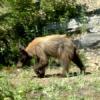Leaderboard
Popular Content
Showing content with the highest reputation on 04/10/2020 in all areas
-
Dear hiflier, Please realize that I am only on an obsessive quest for answers, I'm no expert, but I'm just showing what I find. Ever since they whooped at me in April of 2012, there hasn't been a day gone by that I didn't think about them. So I am really glad you are asking all these questions. I have only found one other type of nest, in which if you had a hundred little saplings, sometimes you'll come across a patch of them where they were all laid down in the same direction, as if something heavy pushed 20 of them down and slept on them. Other than that, you have to remember rule number 1. They want to leave no trace of their existence, in my opinion, so simple nests that fade back into the forest after a few years, are the ones that I imagine they would be making. Thanks for pointing out the Olympic Peninsula nests, because I hadn't seen them, but I see it now on Cliff Barackman dot com. I haven't followed Cliff because of how I see them research on the show, Finding Bigfoot. If you ever want to find bigfoot, don't do anything that they do on that show, that's just my opinion. I'm talking whooping, and hollering, and woodknocks, and parading around at night with 20 people. But, it would appear that my bigfoot friends, and Cliff Barackman's friends, and the lowland gorillas, all make their nests on the ground. Different geographic areas have different flora, which means different nests. Much in the same way indigenous people's homes are constructed by the most readily available material, forests-wood, desert-adobe, plains-animal skins, etc. I have subscribed and watched true boots on the ground researchers from all over the country. Mid-atlantic appears to have very few eastern hemlocks, so I haven't figured where they would sleep, but a man Ken King and his wife down in Arkansas, claims to have found some nests, and it looks like somebody piled up a bunch of pine needles next to a tree. I wish I could comment about everyone's area, but I only know mine. By the way, check out Ken King Arkansas Bigfoot, great channel. The nests that I show are close to a trail, but as far as I know, I'm the only one whoever walks on that trail. So, in essence, the bigfoot think they are safe. But imagine this, I am going to go out there this weekend, either Sat or Sun depending on weather, but we recently got a big rain, I don't even know if I can make the mile with my wife's Ford Edge. My Dodge Dakota 4x4 went to the junkyard. And even if I can make it out there, my stomach is churning, because if the nest is there, I doubt if I'll see them, but as I approach they will surely have run off into the forest just far enough to not be seen but still be able to observe me. They will be close in that case no doubt. And I have to weigh getting evidence against not having them pack up and leave the area. So I'm fighting fear, but less so than in past years, because they are just like you and me. If you get too close, they'll let you know that you need to leave. But yeah, I've regretted not lingering over the nests last year and looking real close for hair or anything, I'll need to bring my readers, my eyes are 55 yrs old. I know they'll be back in the same spots, just a gut feeling, because all of the activity over the past 9 years has been centered around these nests, and I didn't even know they existed until 2019. I guess bringing in an expert, would be a good thing, but I don't want to go public yet, because of ridicule and risk to my occupation. So how do you broach the subject with a scientifically minded person, without looking like a whack job? That is why, if I can get independent verification of these types of nests, it would actually go a long way towards understanding. These nests validate rule #1, never be seen by people. They are created once all the snow melts, because once all the snow melts, the forest people can leave their winter abodes(they don't migrate) without leaving foot prints. They place the twigs on the ground to help guard against cold and wet. The new green twigs are much better than old brown twigs for creature comfort. Once, the end of May hits, they'll still use the nests, but there is no need to replenish the green twigs because of years of twig buildup. And by the end of May, they'll have full leaf cover to hide their movements. This fits the scenario for what I have been witnessing. Don't worry about me not finding any more evidence, because these nests, along with past experiences, have helped me narrow down their inner most sanctum. And if I see the nests again, I will check every trail I know on the 4 mile circumference of this hill, because that will let me narrow it down even further. These are nests for bigfoot sentries to watch out for humans, no doubt in my mind. And their inner most sanctum is the hardest part of the hill to reach. I am urging others, because most people here already know or believe in the existence of the forest people, as I like to call them. Independent verification affords me some credibility, and also reinforces a likely profile. But I am starting to wonder, how many actual boots on the ground do we have? I am starting to think that I am all alone in central New England, because of the response thus far. But I will report back, no matter what comes. Someday, I'll get some people smarter than me involved, but not just yet. Thanks. Hey guys, I definitely didn't down vote anybody, in fact I'm new here, I don't even know how to down vote. Actually, If you read my new user message I wrote, I have very thick skin, so ask anything you want, just don't be dumb and insult my family, religion, or President, because I also have very big fists.2 points
-
1 point
-
@hiflier I'm not the one that down voted you but I"m guessing its because you came off a bit critical. He's out there hiking the woods and documenting what he finds. My opinion on his nest find aside, he's out there presenting his opinion and his finds via video which is better than most. You seem to come off as saying because he has been doing this for X years but not getting science involved is a bit preachy. Especially considering most BF'ers always tote the "I"m not trying to prove it to anyone else" line. He's out there doing his thing and presenting his findings. He's not bringing science into it but he is not required to do so, your post could give the impression he owes something to science or the field. Just my thoughts, not saying it was your message.1 point
-
My hands are similar to yours. I have wide palms, but short, stubby fingers. I never liked double stacked semi-autos, hated the "crunch'n'ticker" triggers on older double action semi-autos, and loved the custom rubber grips available for revolvers. But the striker trigger design, bottom rails, and easily attached lights changed all that for me for outdoor carry. I'll live with the fat grips for the 16 round capacity. And while the 10mm energy is between that of the 357mag and 41mag, the complete lack of reloading need (even though a reload is quick and easy) makes up for that in my opinion. I'll shoot single stack 9mm weapons at the range, and carry the Glock 20 in the field during bear season. But my snowmobile gun remains the S&W 629. It rides in a flap holster on the handlebars. Six rounds of 240 grain 44 mag is plenty for aggressive moose, and the bears are asleep...........usually.1 point
-
I've got a Glock 40 MOS (10mm) which is a long-slide version of the Glock 20. The 10mm is a fantastic woods gun. I bring the Glock 40 MOS when I'm sasquatching with another person. When alone, and know I can't rely on backup, I bring the Ruger Toklat. If I can only get one shot off, I want it to count. Jerry Miculek has a natural advantage. His hands are absolutely massive and he can grip a 44 magnum like I grip a Kimber Micro. That helps.1 point
-
I've never been a gun guy so my experience is limited..I never owned a firearm till I was about 41..As far as a pistol.. I started out carrying a Sig Sauer P210 9mm, I've never liked a large caliber pistol. I have a .357 but I feel like the joker pulling his revolver out in the first Batman movie, when I carry it. When I captured proof of my trespassers on my property, I new I needed something other than the 9mm..wanting to stick with a small compact, carry anywhere pistol, I went with the Kimber Crimson .45 Ultra CDP II Still not powerful enough but at least I'll die shooting a comfortable easy to handle gun.1 point
-
0 points
-
So, FelixTheCat, this has been educational to be sure. There is a dynamic that maybe you could go into a little regarding your own viewpoint on suspected Sasquatch nesting behavior. Off the bat, do you think that the supposed Sasquatch nesting sites found in the Olympic Peninsula, May of 2015, would be more in keeping with what the creatures might construct. Those nests were compared to the nesting behavior of Western Lowland Gorillas which primitively weave twigs into a structure almost on a daily basis. One question would be have you noticed any nesting behavior more sophisticated that what you have found and shown on your videos? Another question would be do you think that nesting behavior found in one region would be different than behavior in another region and why? A third is, if these nests areas that you find are so close to trails and, IMHO, not the least bit elaborate, then they are made quickly and not meant for long term use? That said, their location close to trails, even though not obvious, should afford an opportunity to collect hair samples or fecal material? And lastly, Have you thought of contacting any wildlife experts, or biologists, from a nearby academic institution to perhaps give an opinion or take a soil sample from in or around the nests? You say you've been dealing with this for years with different types of experience and encounters so I get the impression that you may just keep on for years without a solid piece of evidence for this creatures existence. Do you think it may be time to see if some solid evidence could be acquired by a specialist in the field of wildlife behavior familiar with the area, or a geneticist who might be curious about the structures and what/who may have made them. I say all of this because you have been urging people to go out this Spring and find some nest sites of their own but ultimately how would this progress the subject any further what what you have already done? I mean, I give you kudos for finding these and investigating the possibilities so don't get me wrong. However, I also think it's time to go further and not stop short by finding a nest site, videoing it, and more or less just leave it t that. Do you think it's time to get some science involved in order to gain a definitive answer beyond you yourself being satisfied with who/what is making these structure?-1 points
This leaderboard is set to New York/GMT-05:00








